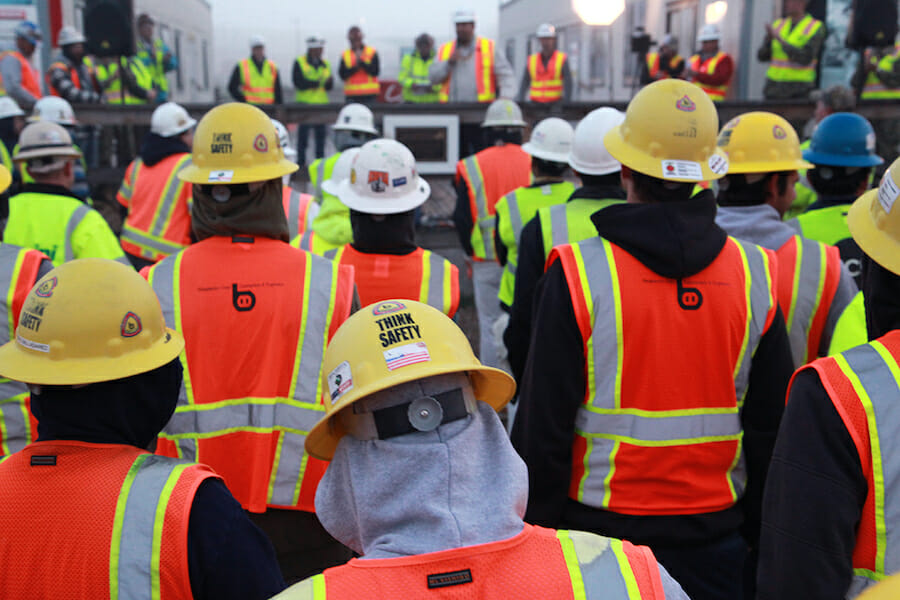
Business
Trump is Making American Workplaces Unsafe Again
Like so many other politicians before him, Trump’s campaign was built on promises. He promised a border wall with Mexico to stop “drug dealers” and “rapists,” he promised a ban on all Muslims entering the US, and he promised a safer country.
In the closing moments of Trump’s inaugural address, he says, “We will make America safe again. And, yes, together, we will make America great again.” His choice of words here aims to put his promises — of a United States free from Muslim immigration and free from Mexican “rapists” — in a positive light. To Trump and his supporters, this is not about xenophobia; it’s about safety.
The issue with this positive spin on Trump’s vision for the United States is that many of his policies have contradicted this stance. Yes, Trump’s policies on immigration are as tough as you’d expect them to be considering his campaign promises, but his policies on workplaces are helping the US to continue to fall behind with regards to workplace safety.
#FakeHistory
Trump talks about making America “safe again,” but the United States has never been particularly safe — at least not in its workplaces. In 1999, the United States had a workplace fatality rate of 5.3 per 100,000 workers according to a global report by the World Health Organization.
In the same report, Poland did slightly worse than the United States, but Slovenia and Croatia did better. Considering that those countries were communist states just over a decade earlier, the US should have been a lot safer than them.
In 2014, another report on workplace fatality rates was released by HSE. This report showed how ex-communist countries’ workplace fatality rates had improved dramatically. Slovenia and Croatia, for example, had a workplace fatality of less than one per 100,000 per year.
For the same year, the workplace fatality rate in the US was 3.6 per 100,000 workers, according to a report from OSHA. The US had decreased its workplace fatality rate from 5.3, but this is nowhere near as fast as the communist countries had decreased theirs. It’s also higher — significantly higher — than most other countries in Europe.
Even countries which have far lower GDPs per capita than the United States — the Czech Republic, Portugal, Estonia, Greece, Hungary, Latvia, and Cyprus — all have much safer workplaces. The average American is nearly five times more likely to die at work than the average Estonian. This is despite the fact that the average American earns almost twice as much money per year as the average Estonian.
In short, Trump cannot make America “safe again.” To suggest that he can is to willfully distort history. The very best he can do is to make America safe. However, if recent policy announcements are anything to go by, he’s not even doing that.
OSHA, HSE, the US, and the UK
OSHA is the US government body responsible for safety in the US workplace. It organizes safety inspections, helps to craft safety legislation, and it offers guidance which helps normal, working people make sense of the legalese used in the US’s safety legislation.
In the UK, the direct equivalent of OSHA is HSE. It does all of the same things OSHA does. Yet, if the UK’s workplace fatality rate is anything to go by, it does those things much better. In fact, you could say it does those things 900% better seeing as the UK’s workplace fatality rate — at 0.4 per 100,000 per year — is nine times lower than the US’s.
How on earth this happened is not just a matter of a lack of resources. It’s also a lack of regulation and a lack of the free market. OSHA resources and regulation have always been thin compared to the UK and Europe, hence the problems US workplaces have had pre-2016, yet Trump is determined to make them even thinner.
To start with, Trump has decreased OSHA’s budget. At $543,257,000, it’s still a lot of money when compared to the UK’s $198 million budget. However, the UK’s population is a fifth of the US while its HSE budget — even after drastic cuts — is over a third of the US’s.
Then, there’s the matter of manpower. OSHA has around 2,100 federal inspectors and state-affiliated inspectors. HSE has 980 inspectors, and this is after a 25% decrease. The US has over twice as many inspectors as the UK, but it also has a population which is five times greater than the UK.
What’s more, the UK has introduced legislation which has allowed for the rise of private workplace inspectors. The CDM Regulations 2015 and HSE’s HSG76 give private safety inspectors the power to make the kinds of decisions that HSE or OHSA inspectors can make. As such, there are a lot of private safety inspectors in the UK. In fact, about 100 safety inspectors in the UK are responsible for racking safety alone.
Trump disagrees with this approach, and this is why “job-killing regulations” have been slashed. The idea is that — with less regulation — there is a higher incentive for businesses to hire workers. This reduces unemployment and it helps the economy to grow. In practice, what it means is regulation which is specifically designed to protect workers has been axed in the name of helping big businesses.
It may well help to produce more jobs. Yet, the UK shows that you can introduce jobs to the health and safety sector, while simultaneously increasing regulation and decreasing spending. It’s not a case of regulation versus jobs; you can have both.
It’s not as if the UK’s approach is anti-Republican either. As mentioned above, HSE spending has been cut because this is precisely the mentality of the UK’s Conservative government. Critics have argued against this, and the critics may well have a point, but the UK’s workplace fatality rate remains low.
Trump, however, would rather have less of everything. He doesn’t want to spend money on workplace safety, but he also doesn’t want to introduce privatization to fill the gap left by less spending on workplace safety. He doesn’t want to introduce regulation for workplace safety, and he doesn’t even want to hear anything from a panel about workplace safety. Rather, Trump would like the whole issue to just go away.
This is likely why he has scrapped the need for employers to so much as report on the number of deaths and injuries that happen at their workplaces. So, even if the workplace fatality does skyrocket during the Trump administration as a direct result of his policies, we may never know. Trump is giving companies a free pass to be completely unaccountable for their actions.
Finally, there’s chemical safety. What was once a bipartisan piece of legislation limiting the chemicals businesses are allowed to use in their products is being taken apart by the cronyism of the Trump administration.
Both Republicans and Democrats agreed that certain toxic chemicals were dangerous for both employees and the general public back in 2016, and this is why this bipartisan legislation passed in the first place. Yet, Trump has decided to err on the side of danger. This could be because he believes these regulations are also “job killing,” or it could be just for the sake of sticking it to the previous administration.
When the people of the United States look back on Trump’s inauguration speech, it will undoubtedly be with divided opinion. Supporters of Trump will continue to claim that he delivered on his promises, and they will likely claim that he made America great again. Yet, despite his promise, there is no possible way that anyone could say with any certainty that Trump made America safe again.

